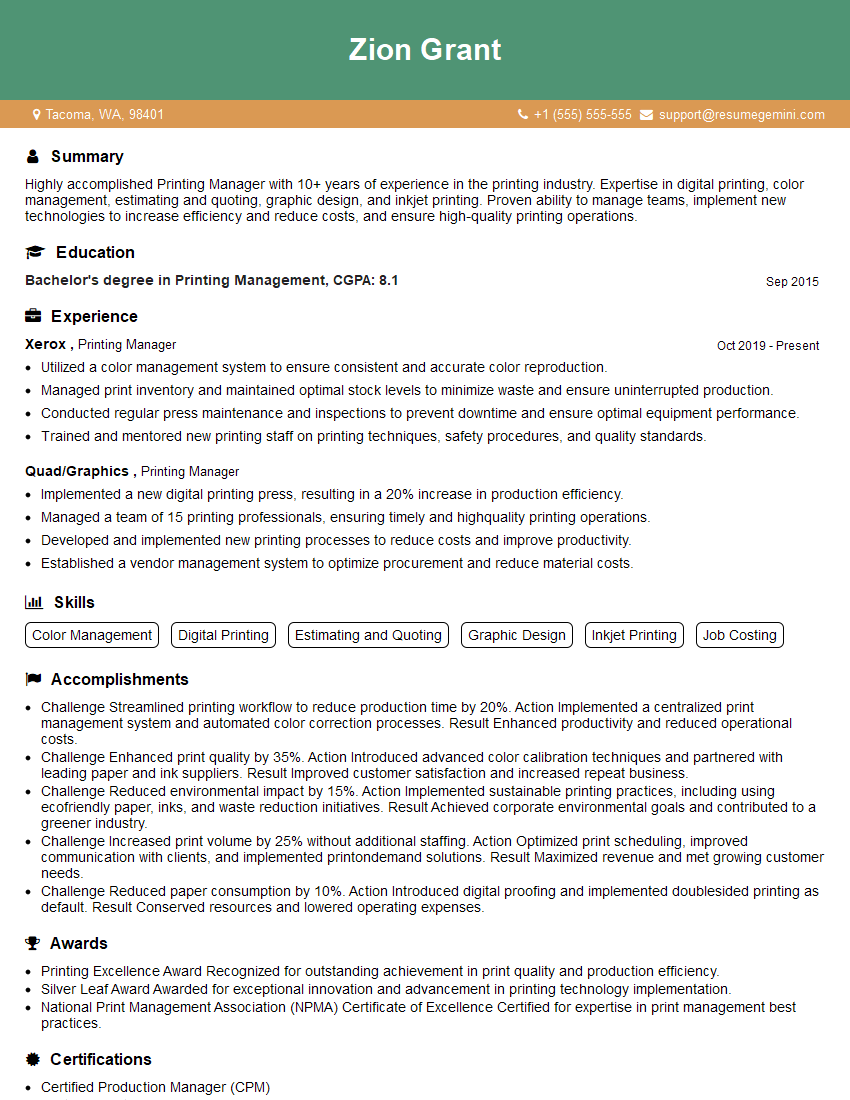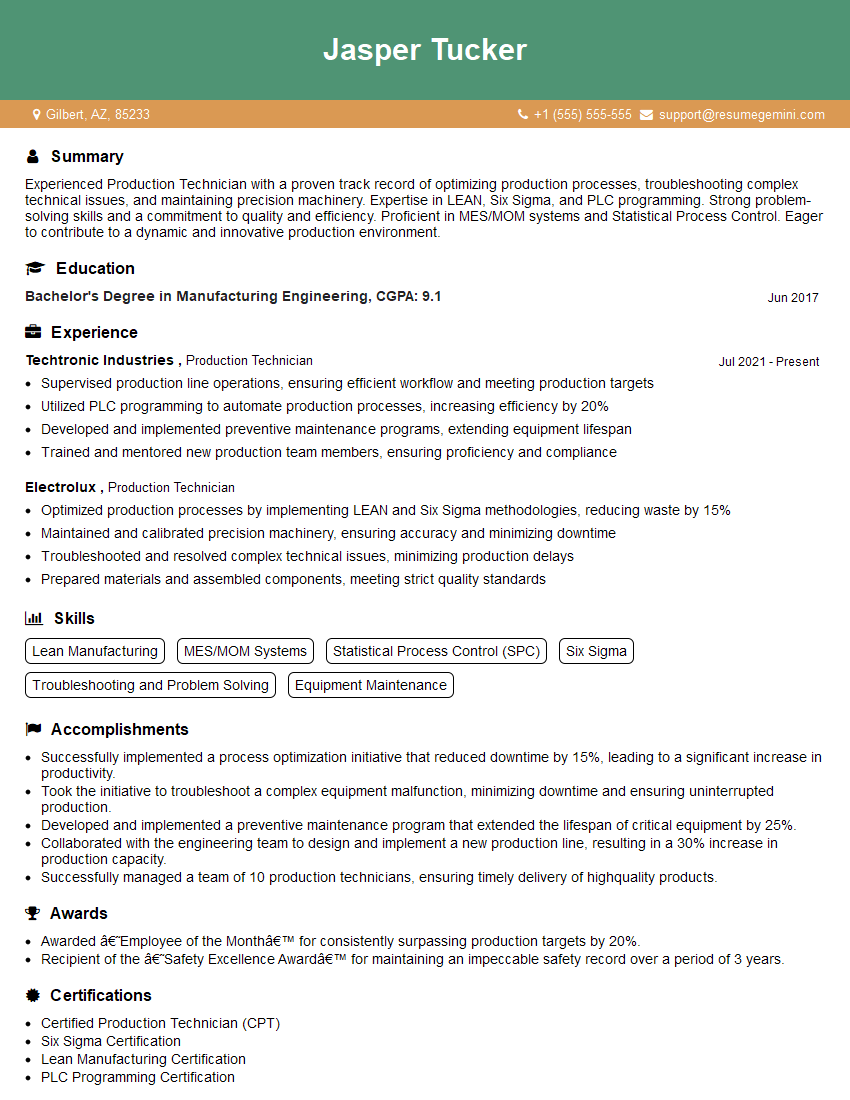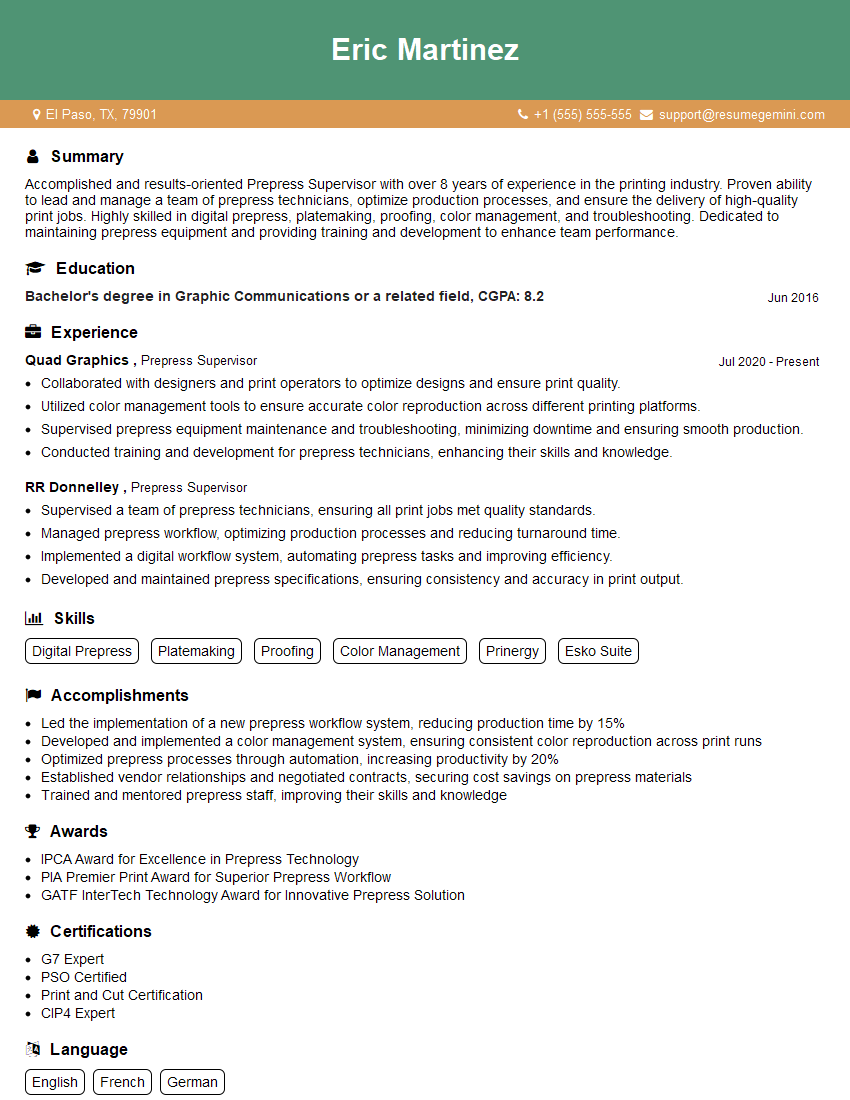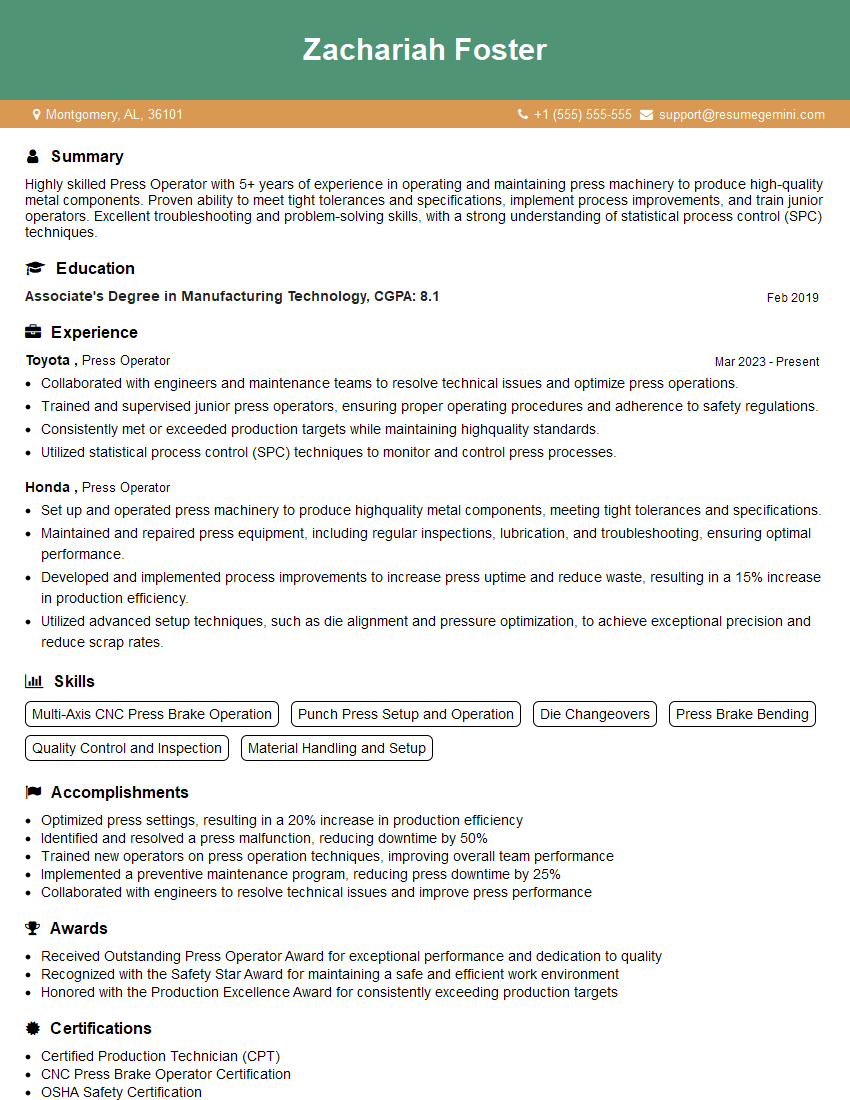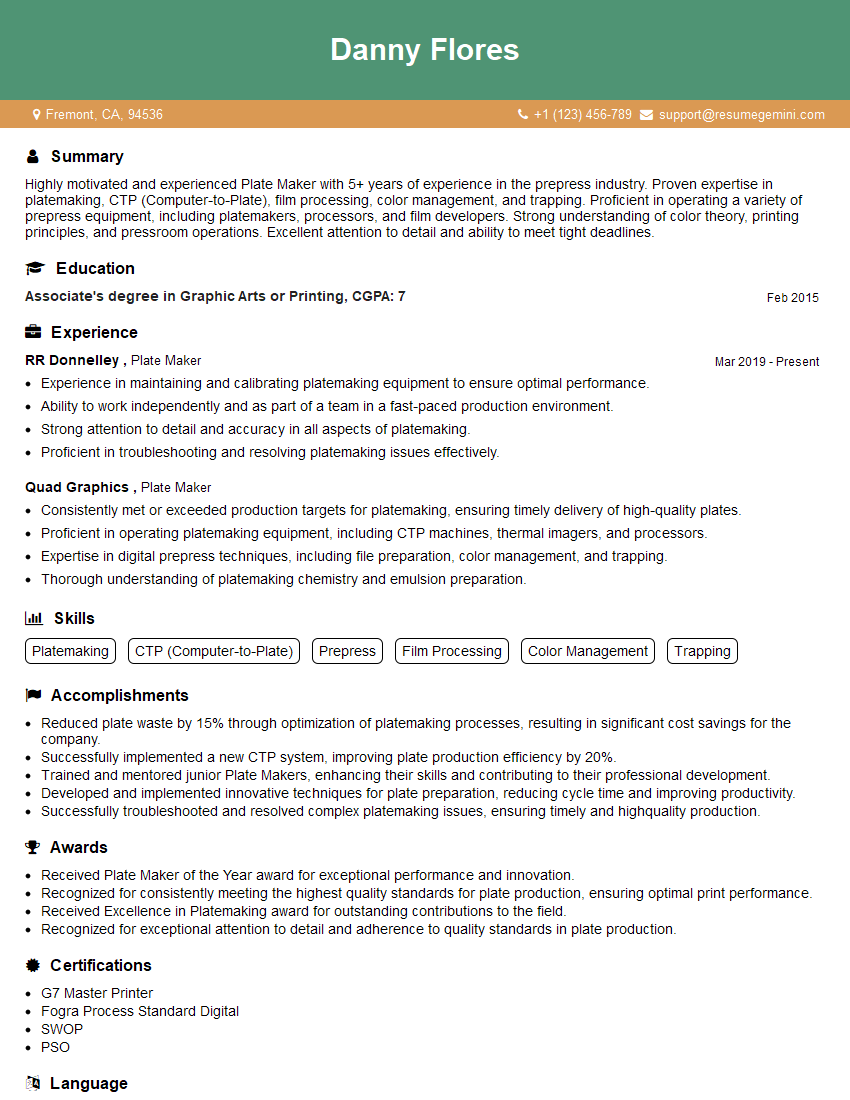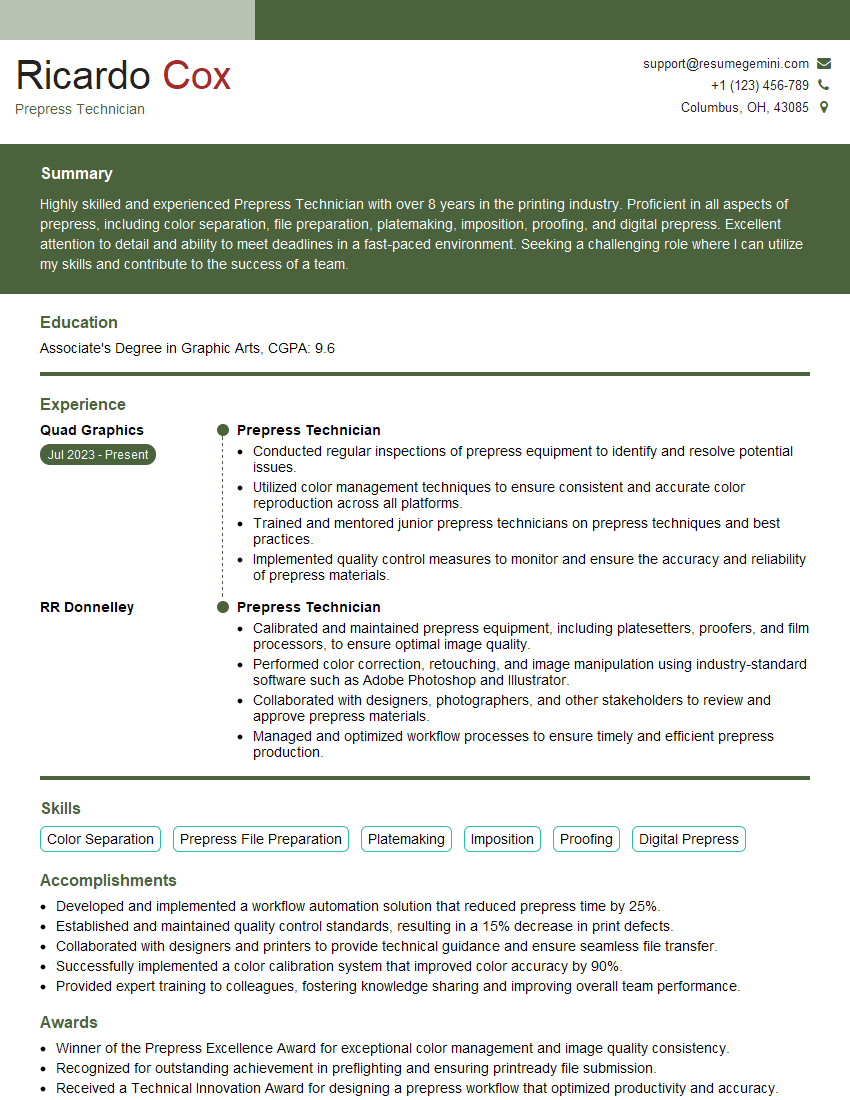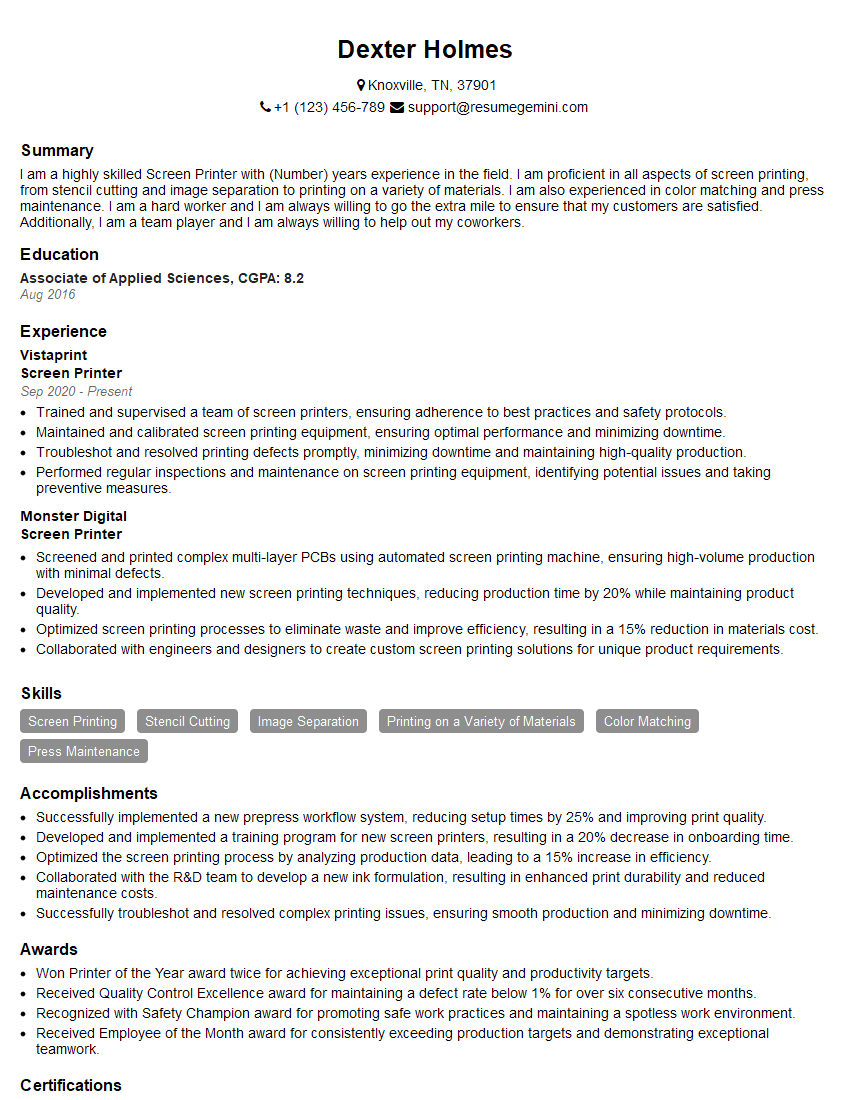The right preparation can turn an interview into an opportunity to showcase your expertise. This guide to Plate-making interview questions is your ultimate resource, providing key insights and tips to help you ace your responses and stand out as a top candidate.
Questions Asked in Plate-making Interview
Q 1. Explain the difference between CTP and conventional platemaking.
The main difference between Computer-to-Plate (CTP) and conventional platemaking lies in how the image is transferred onto the plate. Conventional platemaking, also known as indirect platemaking, uses a film intermediate. An image is first created digitally and then outputted onto film. This film is then used to expose the printing plate, transferring the image. Think of it like making a photo copy: the film is the intermediary. CTP, on the other hand, is a direct imaging process. The digital image is sent directly to the platesetter, which exposes the plate without the need for film. This is faster, more efficient, and eliminates the film stage, reducing costs and potential errors associated with film handling and processing. It’s like printing directly from a digital file to a photo paper – a much more streamlined process.
Q 2. Describe the process of plate mounting.
Plate mounting is the crucial process of precisely attaching the printing plate to the cylinder of the offset printing press. The accuracy of this step directly impacts the quality of the final print. It usually involves several steps:
- Cleaning the plate and cylinder: Both surfaces must be meticulously cleaned to ensure proper adhesion and prevent problems like ghosting (faint, unwanted images).
- Applying adhesive: A thin layer of plate mounting adhesive is applied to the back of the plate, ensuring even coverage. The type of adhesive varies based on plate material and press type.
- Positioning the plate: The plate is carefully positioned on the cylinder using registration pins or marks, ensuring perfect alignment with the other plates if printing multiple colors. This is often guided by precise measurements and registration targets.
- Securing the plate: Once aligned, the plate is firmly pressed against the cylinder, often using a vacuum system or rollers to remove air bubbles and ensure a secure bond.
- Final inspection: A final check is performed to ensure proper adhesion and that the plate is securely mounted and registered.
Improper mounting can lead to misregistration (images not aligning correctly across colors), plate slippage during printing, and poor print quality. Think of it like perfectly aligning puzzle pieces – even a slight misalignment will result in an imperfect picture.
Q 3. What are the common types of printing plates used in offset printing?
Common types of printing plates used in offset printing include:
- PS Plates (Photosensitive Plates): These plates are typically used with conventional platemaking and are coated with a light-sensitive emulsion. They are exposed to UV light through a film negative to create the image.
- CTP Plates (Computer-to-Plate Plates): These plates are directly imaged by a platesetter and come in various types, including thermal, violet laser, and UV laser. The choice depends on the platesetter and desired resolution.
- Surface Plates: A more economical choice offering shorter runs. The image area is slightly raised from the non-image areas
- Waterless Plates: Designed for waterless offset printing, these plates have a unique surface chemistry that eliminates the need for dampening solution. This results in better print quality and reduces environmental impact.
The selection of plate type depends on factors like print run length, press type, desired image quality, and budget.
Q 4. How do you ensure proper plate registration?
Proper plate registration is crucial for multi-color printing, ensuring that different color images align perfectly. This is achieved through a combination of:
- Precise plate mounting: As described earlier, accurate placement of the plate on the cylinder is essential. Registration pins and marks on the plate and cylinder provide alignment points.
- Accurate pre-press workflow: The creation of the printing plates from the digital files must be precise. Software and hardware calibration are vital to minimize registration errors.
- Press calibration: The printing press itself needs to be properly calibrated to ensure that the cylinders rotate in precise synchronization. Regular press maintenance and adjustments are crucial.
- Use of registration marks: Crosshair or other registration marks are incorporated into the design. These help the press operator fine-tune the alignment and ensure accurate registration during printing.
- Regular monitoring: During the print run, the operator monitors the registration, making minor adjustments as needed to maintain consistent alignment.
Misregistration leads to blurry images, color shifts, and unacceptable print quality. Imagine printing a picture of a flag – inaccurate registration will result in the colors of the flag not lining up correctly.
Q 5. What are the different types of plate materials and their applications?
Printing plates are made from various materials, each with its own characteristics and applications:
- Aluminum: The most common material due to its lightweight nature, durability, and relatively low cost. It’s suitable for a wide range of applications and print lengths.
- Polyester: Often used for flexible plates, suitable for applications such as wide-format printing or packaging. It offers good flexibility and durability.
- Polycarbonate: A durable and resilient material, but more expensive than aluminum. Often used for longer print runs or demanding applications.
The choice of material depends on factors such as print run length, required durability, desired image quality, and budget considerations. For example, a short-run job might use aluminum plates to keep costs low, while a long-run packaging project might opt for more durable polycarbonate plates.
Q 6. Explain the process of image transfer to a printing plate.
The image transfer process depends on the platemaking method:
Conventional Platemaking: The image is initially created digitally and then outputted onto film. This film, which is a negative, is then placed in contact with the photosensitive plate and exposed to UV light. The exposed areas of the plate undergo a chemical change, becoming either hydrophobic (water-repelling) or hydrophilic (water-attracting), depending on the type of plate. The unexposed areas are then washed away, leaving the image on the plate.
CTP (Computer-to-Plate): The digital image file is sent directly to the platesetter, which uses a laser (thermal, violet, or UV) to expose the plate. The laser exposes specific areas of the light-sensitive coating on the plate, creating the image. Then, the plate undergoes processing to remove the unexposed areas, leaving the hardened image on the plate.
In both methods, the exposed areas of the plate are treated to repel ink (image areas), while the unexposed areas are treated to accept water (non-image areas) in standard offset printing.
Q 7. How do you troubleshoot common platemaking issues?
Troubleshooting platemaking issues requires a systematic approach. Common problems include:
- Poor image quality: This can be due to issues with the digital file, platemaking process (exposure, processing), or press conditions. Check for low resolution files, improper exposure levels, or worn-out processing chemicals.
- Plate defects: Scratches, pinholes, or other damage to the plate can cause issues. Carefully inspect the plate for any damage before mounting.
- Misregistration: Improper plate mounting, press calibration, or pre-press workflow errors can cause misregistration. Check the alignment of registration marks and calibrate the press accordingly.
- Plate scumming: This refers to unwanted ink on non-image areas. This can be caused by improper plate processing, insufficient dampening, or ink issues. Check the plate processing chemicals and the press settings.
A methodical approach involves first identifying the symptom, then checking each stage of the platemaking and printing process to pinpoint the root cause. Consulting technical manuals, seeking help from experienced professionals or manufacturers is also important.
Q 8. What are the quality control checks performed on printing plates?
Quality control in platemaking is crucial for consistent, high-quality prints. We perform a multi-stage process, starting even before the plate is made, ensuring the digital file is optimized. Once the plate is produced, we conduct several checks:
- Visual Inspection: We meticulously examine the plate for any scratches, blemishes, or imperfections that might affect the print quality. Think of it like examining a photograph before printing – you wouldn’t want a smudge to ruin the final image.
- Density Measurement: We use a densitometer to measure the density of the different areas on the plate. This ensures the dots are the correct size and density, crucial for achieving accurate color reproduction. A densitometer measures the light reflected from the plate, giving us a precise measurement of the dot gain.
- Exposure Check: We verify the exposure settings of the platemaking machine to ensure optimal image transfer. Incorrect exposure can lead to underexposed or overexposed areas, affecting print quality.
- Proofing: A critical step involves printing a test sheet from the plate to visually assess the image quality, color accuracy, and dot sharpness before going to full-scale production. This allows for timely corrections if necessary.
- Microscopic Examination (if necessary): In cases of particularly challenging prints or suspected plate issues, we’ll use a microscope to examine the plate surface at a microscopic level, identifying even minor defects that might not be visible to the naked eye.
These checks, when done thoroughly, help to prevent costly reprints and ensure customer satisfaction.
Q 9. How do you maintain platemaking equipment?
Maintaining platemaking equipment is paramount for consistent performance and longevity. It’s akin to regularly servicing your car – preventative maintenance is far more cost-effective than dealing with major breakdowns. Our maintenance routine includes:
- Regular Cleaning: We clean the machine daily, removing any residual chemicals or debris. This prevents build-up that can affect plate quality and machine function. Think of it as wiping down your kitchen counters after each use – it prevents larger messes later.
- Scheduled Servicing: We conduct scheduled preventative maintenance according to the manufacturer’s recommendations. This often includes replacing worn parts, lubricating moving components, and checking for any signs of wear and tear.
- Calibration Checks: We regularly calibrate the platemaking machine to ensure accuracy in exposure and dot size. This is like ensuring your kitchen scales are accurate – inaccurate measurements will lead to inconsistencies.
- Operator Training: Proper operator training is crucial to prevent accidental damage or misuse of the equipment. Well-trained operators understand the delicate nature of the machinery and perform their tasks with care.
- Environmental Control: Maintaining a stable temperature and humidity level in the platemaking area is vital. Fluctuations can significantly affect plate quality and machine performance.
A well-maintained platemaking machine minimizes downtime, ensures consistent plate quality, and extends the lifespan of the equipment, ultimately saving the company money and improving productivity.
Q 10. What are the safety precautions involved in platemaking?
Safety is a top priority in platemaking. We work with chemicals, lasers (in some processes), and heavy machinery; therefore, stringent safety precautions are essential. These include:
- Personal Protective Equipment (PPE): We always use appropriate PPE such as gloves, safety glasses, and lab coats to protect ourselves from chemical splashes or laser radiation. This is non-negotiable.
- Chemical Handling: We follow strict protocols for handling and storing chemicals, ensuring proper ventilation and using appropriate safety containers. Chemical spills are dealt with immediately and correctly.
- Laser Safety: For laser platemakers, we have safety interlocks and protective shielding in place to prevent accidental exposure to laser radiation. Access to the laser area is strictly controlled.
- Machine Guards: All moving parts of the platemaking equipment are properly guarded to prevent accidental injury.
- Emergency Procedures: We have clearly defined emergency procedures in place for handling chemical spills, equipment malfunctions, or any other unforeseen events. Regular drills ensure everyone is prepared.
- Regular Safety Training: All personnel receive regular safety training to ensure they are aware of all risks and safety procedures.
By adhering to these safety procedures, we maintain a safe working environment and minimize the risk of accidents and injuries.
Q 11. Explain the concept of dot gain in platemaking.
Dot gain refers to the increase in the size of a halftone dot during the printing process. Imagine printing a tiny dot – on the plate it might be 1mm, but after printing on paper, it might measure 1.2mm. That extra 0.2mm is the dot gain.
Several factors contribute to dot gain, including the type of paper used, the ink used, and the printing pressure. Excessive dot gain leads to muddy, unclear images, while insufficient dot gain results in thin, weak images.
Controlling dot gain is essential for achieving accurate color reproduction and image sharpness. We manage it through careful selection of printing plates, inks, papers, and by calibrating our printing presses. We might even use specialized software to compensate for expected dot gain during the pre-press process.
Q 12. How does the screen ruling affect the quality of the printed image?
Screen ruling, measured in lines per inch (lpi), determines the fineness of the halftone dots used to create a printed image. A higher lpi means finer dots, resulting in a smoother, more detailed image, but it also requires higher quality plates and inks. A lower lpi gives a coarser image, but may be more suitable for certain paper types or printing techniques.
The choice of screen ruling depends on several factors including the type of paper, the printing process, and the desired level of detail. For example, high-quality magazines might use a higher lpi (e.g., 175 lpi) for sharp details, while newsprint might use a lower lpi (e.g., 85 lpi) due to paper limitations. Selecting the incorrect screen ruling can result in moiré patterns (unwanted interference patterns) or loss of detail. Careful consideration is crucial for optimal print quality.
Q 13. Describe the process of cleaning and storing printing plates.
Cleaning and storing printing plates correctly prolongs their life and prevents degradation. The cleaning process depends on the type of plate (e.g., conventional plates, CTP plates), but generally involves:
- Initial Cleaning: Immediately after use, remove excess ink or chemicals using appropriate solvents. We always follow manufacturer recommendations for specific plate types.
- Thorough Cleaning: A more thorough cleaning process follows, often involving specialized cleaning solutions and equipment to ensure complete removal of residues.
- Drying: Plates must be thoroughly dried before storage to prevent mold or mildew growth.
Storage is equally important. Plates should be stored in a cool, dark, and dry place, ideally in protective sleeves or holders to prevent damage or scratching. Proper storage prevents degradation and ensures that plates are ready for reuse or archiving when needed.
Q 14. What is the importance of plate density in achieving desired print results?
Plate density, measured by a densitometer, refers to the amount of light absorbed by the image areas on the plate. It directly affects the tonal range and overall density of the final print. Insufficient density results in pale or weak images, while excessive density leads to overly dark or blocked-up areas.
Achieving the desired print results requires precise control of plate density. This is influenced by factors like the exposure time during platemaking, the type of plate, and the characteristics of the printing ink. Proper calibration of the platemaking equipment and careful monitoring of density throughout the process are essential to ensure consistent and accurate print results. A skilled platemaker understands how to adjust these factors to attain the ideal density for the specific print job. Think of it like adjusting the contrast on a photograph – it significantly impacts the overall look and feel.
Q 15. How do you handle different plate sizes and formats?
Handling different plate sizes and formats in platemaking requires a versatile approach. We use specialized platemaking equipment capable of processing a range of dimensions, from small labels to large-format posters. The process starts with selecting the appropriate plate material and size based on the printing job specifications. Then, the imaging system—whether it’s a computer-to-plate (CTP) system or a film-based system—is configured to match the required dimensions. For example, if we’re producing plates for a narrow-web press, we’ll use smaller plates, carefully ensuring accurate alignment and registration. For wide-format work, larger plates necessitate precise handling to avoid distortion or damage during the imaging and processing steps. We also need to consider the plate format—whether it’s a sheet-fed or roll-fed format—which affects the mounting and processing techniques. In essence, flexibility and precision are key to successfully handling the variety of plate sizes and formats encountered in the industry. Regular calibration and maintenance of equipment are also critical to ensure consistent and accurate results across the board.
Career Expert Tips:
- Ace those interviews! Prepare effectively by reviewing the Top 50 Most Common Interview Questions on ResumeGemini.
- Navigate your job search with confidence! Explore a wide range of Career Tips on ResumeGemini. Learn about common challenges and recommendations to overcome them.
- Craft the perfect resume! Master the Art of Resume Writing with ResumeGemini’s guide. Showcase your unique qualifications and achievements effectively.
- Don’t miss out on holiday savings! Build your dream resume with ResumeGemini’s ATS optimized templates.
Q 16. What software are you familiar with using in platemaking?
My experience encompasses a wide range of platemaking software. I’m proficient in Esko Suite, including ArtiosCAD for structural design and prepress, and its workflow tools like Automation Engine and PackEdge. I’m also experienced with other leading software like Kodak Prinergy, and various RIP (Raster Image Processor) software, depending on the specific needs of the printing job. This software suite allows me to manage every aspect of plate production: designing plates, creating imposition layouts, optimizing image quality for specific printing substrates, and managing color profiles for consistent results. For example, using Esko’s color management features, I ensure that the final printed output accurately matches the design, even when working with complex color palettes or specialized inks. This software is essential for ensuring precise and efficient plate creation, eliminating manual errors and maximizing productivity.
Q 17. Explain the concept of plate exposure and its impact on print quality.
Plate exposure is the crucial step where the image is transferred from a film or digital source onto the photosensitive plate. The intensity and duration of exposure directly affect the print quality. Under-exposure leads to weak image areas and potential ink issues, resulting in pale or faint prints. Over-exposure, on the other hand, can cause the image to become too dense, leading to hard edges and potential ink build-up, resulting in heavy or smeared prints. Optimal exposure creates a well-defined image with sharp details and appropriate ink density. For example, in flexographic printing, achieving the correct exposure is critical to the accurate reproduction of fine lines and small text. It is carefully controlled based on factors such as plate type, the type of exposure unit (UV, laser, etc.), and the specific ink and substrate being used. In short, precise plate exposure is paramount for obtaining high-quality, consistent prints and maintaining tight registration across the entire run.
Q 18. What are the different types of plate exposure units and their functionalities?
Several types of plate exposure units exist, each with specific functionalities. Ultraviolet (UV) exposure units use UV light to harden the photosensitive layer of the plate. These are common and relatively economical. Laser exposure units (CTP) use a laser to create a high-resolution image directly onto the plate, offering greater precision and efficiency compared to film-based methods. LED exposure units are an emerging technology offering energy efficiency and precise control over the exposure process. The choice of unit depends on factors like the required resolution, plate type, and budget. For instance, a high-volume commercial printer might opt for a high-speed laser CTP system for its precision and speed, while a smaller operation may prefer a UV exposure unit for its lower initial investment. Each unit’s functionalities include parameters such as exposure time, intensity, and light source type, all carefully adjusted based on the plate and print job requirements.
Q 19. How do you determine the appropriate plate thickness for a specific printing job?
Determining the appropriate plate thickness hinges on several factors: the printing press type, the printing substrate, and the desired print quality. Thicker plates, typically used for longer runs and coarser screens, offer better durability and resistance to wear, especially crucial in applications with heavy ink deposits. Thinner plates, commonly used for finer detail and shorter runs, reduce dot gain and enhance print sharpness, making them ideal for high-resolution printing. For instance, a flexible packaging job requiring fine detail would likely utilize a thinner plate, whilst a corrugated cardboard print job might need a thicker one to withstand the higher pressures involved. The plate material also influences thickness choices; different materials have inherent strength properties. The goal is to balance the need for durability with the need for print quality, always considering the specific demands of the printing process and the desired output.
Q 20. Explain the process of making a flexographic printing plate.
Flexographic platemaking involves several steps. First, the artwork is digitally prepared and optimized for flexographic printing, often using specialized software like Esko Suite. This involves adjustments for dot gain and other press-related factors. Next, the image is transferred onto a photosensitive plate, typically using a CTP (Computer-to-Plate) system which exposes the plate directly, or through film in older methods. Then, the plate undergoes a washing and processing step to remove unexposed areas of the photosensitive layer. This leaves behind a raised image that will transfer the ink to the substrate. After processing, the plate is mounted onto a printing cylinder. The final step often involves proofing to verify color accuracy and image quality before commencing the printing run. This ensures consistency and reduces waste. Each step requires careful attention to detail, with proper exposure and processing parameters being crucial for generating high-quality plates that yield optimal print results.
Q 21. Describe the challenges faced during platemaking and how to overcome them.
Challenges in platemaking often involve achieving consistent image quality and avoiding defects. Variations in plate exposure can create inconsistent ink density, while improper processing can lead to plate damage or contamination. Maintaining accurate registration across different colors is critical, especially in multi-color printing. Solutions involve meticulous attention to detail during each step, rigorous quality control procedures, using high-quality materials, and regularly calibrating equipment. For instance, a consistent problem could be a moiré pattern showing in the print, indicating misalignment or interference between screens. This might be resolved by checking the alignment of the plate during mounting, ensuring the press is properly calibrated, or even revising the design artwork to eliminate problematic frequencies. Addressing these issues through preventative measures and systematic troubleshooting significantly contributes to successful platemaking and optimal print quality.
Q 22. What are the environmental considerations related to platemaking?
Environmental considerations in platemaking are paramount. We’re dealing with chemicals that, if not handled responsibly, can negatively impact air and water quality, and contribute to waste generation. Key concerns include:
- Chemical usage: Many platemaking processes involve chemicals like developers, fixers, and cleaners that contain volatile organic compounds (VOCs) and other potentially harmful substances. We need to minimize their usage and ensure proper disposal.
- Wastewater treatment: The wastewater generated from plate processing needs careful treatment before discharge to prevent pollution. This often involves filtration, neutralization, and potentially specialized treatment to remove specific chemicals.
- Plate material: The plates themselves, typically made of aluminum, require energy-intensive manufacturing processes. Selecting plates from responsible and sustainable manufacturers, as well as recycling used plates, is crucial.
- Energy consumption: Platemaking equipment, such as processors and imaging devices, consumes significant energy. Employing energy-efficient equipment and optimizing processes can significantly reduce our environmental footprint.
For example, in my previous role, we implemented a closed-loop system for our developer solution, reducing chemical waste by over 30% and significantly lowering our water consumption.
Q 23. How do you manage and reduce waste in the platemaking process?
Waste reduction is a continuous effort. It’s not just about minimizing the amount of waste generated but also about finding sustainable ways to manage what’s unavoidable. Our strategies include:
- Process optimization: Fine-tuning the platemaking process, such as adjusting exposure times and chemical concentrations, can minimize waste generation. We can also optimize cleaning cycles to reduce water and chemical consumption.
- Chemical recovery and recycling: Where possible, we employ chemical recovery systems to reuse developer solutions and other chemicals, extending their lifespan and reducing the need for fresh supplies.
- Plate recycling: Used plates are valuable recyclables. We partner with vendors who specialize in aluminum recycling, ensuring proper disposal and minimizing landfill waste.
- Lean manufacturing principles: Adopting lean manufacturing techniques helps us identify and eliminate waste in all forms—be it material, time, or energy.
- Regular maintenance: Well-maintained equipment operates more efficiently and produces fewer defects, thus reducing plate waste.
For instance, we recently implemented a system to monitor chemical usage in real-time, providing data-driven insights to optimize our processes and minimize waste.
Q 24. Explain the importance of maintaining accurate color profiles in platemaking.
Accurate color profiles are essential for achieving consistent and high-quality print results. A color profile acts as a bridge between the digital image and the final printed output. Without accurate profiles, colors can appear shifted, dull, or inconsistent across different runs.
Maintaining accurate color profiles involves:
- Regular calibration: We need to regularly calibrate our platemaking equipment, including scanners, imagers, and plate processors, to ensure consistent color reproduction.
- Using standardized color spaces: Working within standardized color spaces, like sRGB or Adobe RGB, helps minimize variations and ensures consistency across different devices and workflows.
- Color management software: Employing robust color management software allows us to create, adjust, and apply color profiles throughout the platemaking process.
- Proofing: Proofing is a critical step that lets us verify the accuracy of the colors before committing to large-scale production.
Imagine trying to bake a cake without precise measurements—the result would be unpredictable. Similarly, accurate color profiles are essential for achieving predictable and consistent color reproduction in printing.
Q 25. Describe your experience with different types of plate processing chemicals.
My experience encompasses various plate processing chemicals, each with its own characteristics, advantages, and drawbacks. These include:
- Alkaline developers: These are widely used for developing conventional plates. They are relatively cost-effective but may require more careful handling due to their corrosive nature.
- Acid developers: Offer advantages in terms of finer detail reproduction and improved environmental profile in some cases but may require more precise control.
- Processors: These contain a combination of chemicals designed for optimal plate development and cleaning. The specific composition varies based on the plate type and intended printing application.
- Gum etchants: Used in various platemaking methods, these solutions etch away areas of the plate, creating a relief image for printing. Proper handling and disposal of gum etchants are critical due to their chemical properties.
I am proficient in handling and maintaining these chemicals safely, following all relevant safety protocols and adhering to waste disposal regulations. Selecting the appropriate chemistry is key to achieving optimal printing results while prioritizing environmental responsibility.
Q 26. How do you ensure the longevity and durability of printing plates?
Plate longevity and durability are crucial for minimizing downtime and maximizing productivity. Several factors contribute:
- Plate material quality: High-quality aluminum plates, with appropriate surface treatments and coatings, are more resistant to wear and tear during the printing process.
- Proper processing: Following the manufacturer’s recommended processing parameters ensures optimal plate development and durability.
- Storage conditions: Plates should be stored in a clean, dry, and cool environment to prevent oxidation and damage.
- Press conditions: Maintaining the printing press in good condition, with appropriate ink and roller settings, minimizes stress on the plates.
- Careful handling: Avoiding scratches, dents, and other forms of physical damage during handling and mounting is essential for prolonging plate life.
In one instance, we improved plate lifespan by over 15% simply by implementing a better storage system and standardizing the plate processing parameters.
Q 27. How do you adapt your platemaking techniques to different printing presses?
Adapting platemaking techniques to different printing presses requires understanding the specific requirements of each press type. Factors such as plate size, thickness, surface properties, and the type of ink used influence the platemaking process.
For instance:
- Offset presses: Require plates with specific surface roughness and thickness for optimal ink transfer.
- Flexographic presses: Need photopolymer plates, often with different thicknesses and surface treatments, depending on the substrate being printed.
- Gravure presses: Use engraved plates which require different preparation techniques and materials.
My experience encompasses adapting platemaking processes for various press types, ensuring that the plates meet the specific requirements of each press to achieve optimal print quality and consistency. This involves selecting the right plate material, adjusting processing parameters, and verifying compatibility before initiating a print run.
Q 28. Describe your experience with troubleshooting and resolving platemaking errors on the press.
Troubleshooting platemaking errors on the press is a critical skill. It involves systematically investigating the problem, identifying the root cause, and implementing corrective actions. Common errors include:
- Plate defects: Scratches, pinholes, or other defects can lead to print imperfections. Identifying the cause (e.g., improper handling, processing issues) and re-making the plate are typical solutions.
- Inconsistent ink transfer: Problems like poor ink coverage or excessive ink buildup can result from issues with the plate, ink, or press settings. Adjusting the ink viscosity, changing the dampening solution, or checking the press rollers are typical troubleshooting steps.
- Color inconsistencies: Variations in color across the print may be due to issues with the plate, ink, or color profiles. Checking color calibration and proofing are essential solutions.
My approach is methodical: I first visually inspect the plate and the print, then check the press settings, and finally examine the platemaking process parameters. Through this systematic approach, we can quickly identify the cause of the problem and take corrective action, minimizing downtime and ensuring consistent print quality.
Key Topics to Learn for Plate-making Interview
- Image Setting and Pre-press Preparation: Understanding file formats (TIFF, PDF, etc.), color profiles (CMYK, RGB), resolution requirements, and proper image manipulation for optimal plate output.
- Plate Types and their Applications: Familiarity with various plate types (e.g., thermal, CTP, analog) and their suitability for different printing processes (offset, flexo, etc.). Understanding the advantages and disadvantages of each type.
- Platemaking Equipment and Processes: Knowledge of platemaking machines (e.g., CTP imagers, plate processors), their operation, maintenance, and troubleshooting. Understanding the chemical processes involved in plate development and exposure.
- Quality Control and Troubleshooting: Identifying and resolving common platemaking issues such as dot gain, image defects, and registration problems. Implementing quality control measures to ensure consistent plate quality.
- Safety Procedures and Regulations: Understanding and adhering to safety protocols related to handling chemicals, operating machinery, and maintaining a clean and organized workspace. Knowledge of relevant industry regulations.
- Workflow Optimization and Efficiency: Strategies for streamlining the platemaking process, minimizing waste, and maximizing productivity. Understanding job scheduling and prioritization.
- Color Management and Proofing: Knowledge of color management principles and the importance of accurate color reproduction. Experience with different proofing methods and their applications.
Next Steps
Mastering plate-making opens doors to exciting career opportunities in the printing and packaging industries, offering diverse roles with excellent growth potential. A strong resume is crucial for showcasing your skills and experience to potential employers. Creating an ATS-friendly resume significantly increases your chances of getting your application noticed. To help you build a compelling and effective resume, we recommend using ResumeGemini. ResumeGemini provides a user-friendly platform to craft professional resumes, and we have examples of resumes tailored specifically to the plate-making field available for your review.
Explore more articles
Users Rating of Our Blogs
Share Your Experience
We value your feedback! Please rate our content and share your thoughts (optional).
What Readers Say About Our Blog
Hello,
We found issues with your domain’s email setup that may be sending your messages to spam or blocking them completely. InboxShield Mini shows you how to fix it in minutes — no tech skills required.
Scan your domain now for details: https://inboxshield-mini.com/
— Adam @ InboxShield Mini
Reply STOP to unsubscribe
Hi, are you owner of interviewgemini.com? What if I told you I could help you find extra time in your schedule, reconnect with leads you didn’t even realize you missed, and bring in more “I want to work with you” conversations, without increasing your ad spend or hiring a full-time employee?
All with a flexible, budget-friendly service that could easily pay for itself. Sounds good?
Would it be nice to jump on a quick 10-minute call so I can show you exactly how we make this work?
Best,
Hapei
Marketing Director
Hey, I know you’re the owner of interviewgemini.com. I’ll be quick.
Fundraising for your business is tough and time-consuming. We make it easier by guaranteeing two private investor meetings each month, for six months. No demos, no pitch events – just direct introductions to active investors matched to your startup.
If youR17;re raising, this could help you build real momentum. Want me to send more info?
Hi, I represent an SEO company that specialises in getting you AI citations and higher rankings on Google. I’d like to offer you a 100% free SEO audit for your website. Would you be interested?
Hi, I represent an SEO company that specialises in getting you AI citations and higher rankings on Google. I’d like to offer you a 100% free SEO audit for your website. Would you be interested?
good

